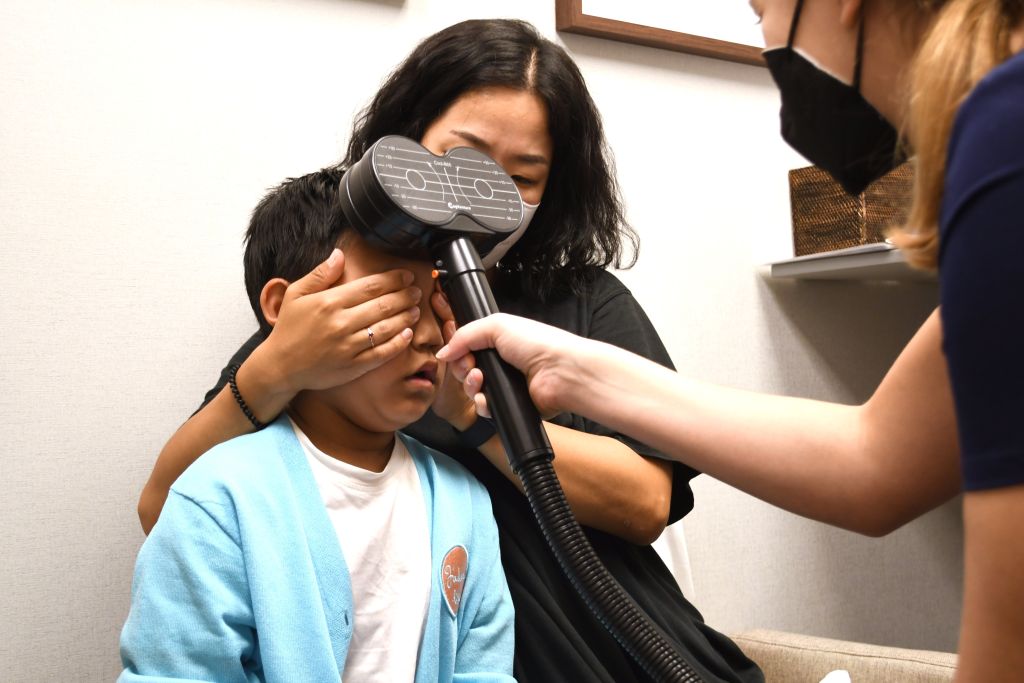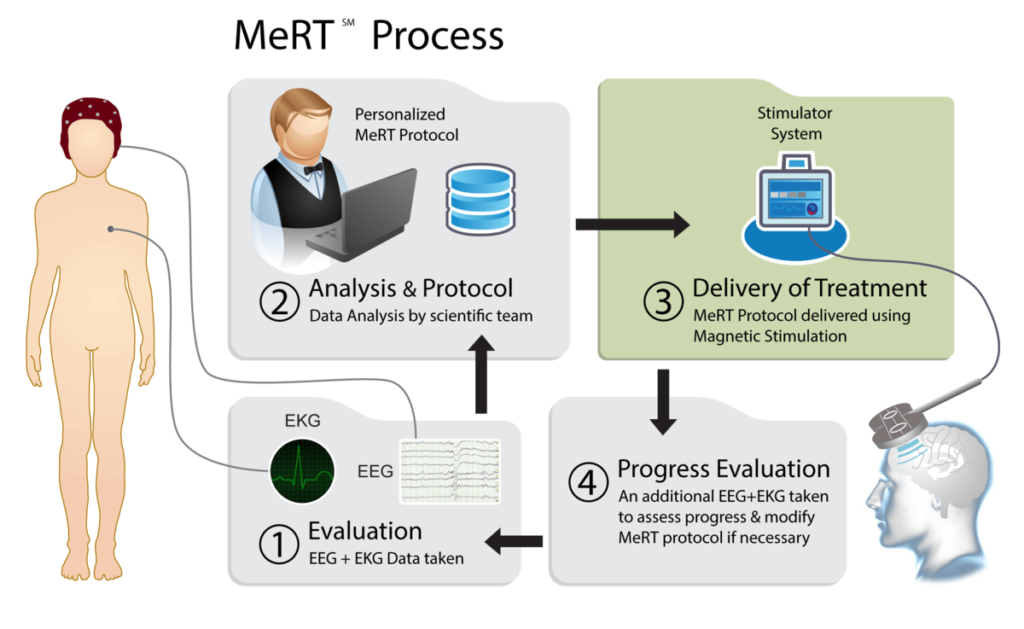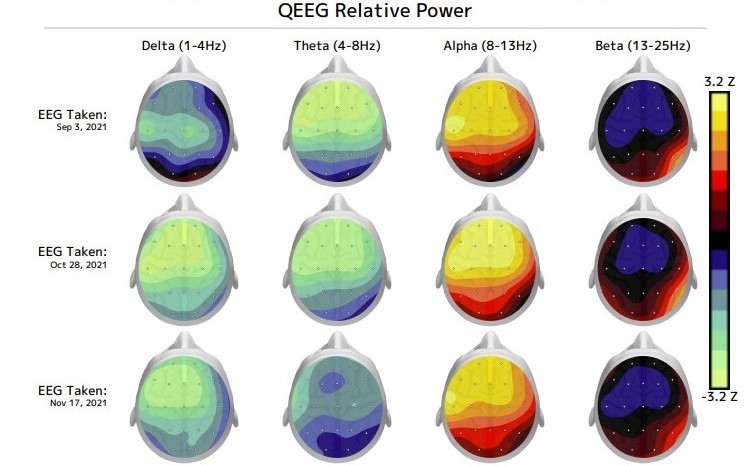Autism is a complex disorder that affects each person differently. People with autism may exhibit impacted language, social skills, behavior, cognition, and ability to function independently.
- qEEG guided therapy
Brainwaves of those with autism often show patterns of disorganization in the front 3/4 of the brain. Brainwaves in these areas consist of a mix of slow (Delta & Theta) and fast (Beta) frequency behavior whereas a neurotypical brain would usually have one dominant frequency in the Alpha band range. MeRT works to entrain the front of the brain to be less disorganized and increase whole brain coherence, which aims to improve sleep, social behavior and overall better quality of life for the child & the family.
ASSESS
Begin with a consultation with our clinician and complete a painless, quick qEEG. The qEEG records brainwave activity to detect any areas of dysfunction. qEEG data is then used to formulate a personalized treatment protocol tailored to your brain’s unique needs.
TESTIMONIALS
THE RESEARCH
- Autism
- Effects of Transcranial Magnetic Stimulation on Children with Low-Function Autism
- Study of the Role of Transcranial Magnetic Stimulation on Language Process in Autism Spectrum Disorder
- Study of the Effect of Transcranial Magnetic Stimulation on a Sample of Children with Autism Spectrum Disorder
- Outcomes From Individual Alpha Frequency Guided Repetitive Transcranial Magnetic Stimulation in Children with Autism Spectrum Disorder- A Retrospective Chart Review
- The Potential of Magnetic Resonance Therapy in Children with Autism Spectrum Disorder
- Altered Neuroplasticity of Prefrontal Cortex in Adult Autism Spectrum Disorder
- A Double-Blind, Randomized Trial of Deep Repetitive Transcranial Magnetic Stimulation (rTMS) for Autism Spectrum Disorder
- Repetitive Transcranial Magnetic Stimulation (rTMS) Improves Movement—Related Cortical Potentials in Autism Spectrum Disorders
- Transcranial Magnetic Stimulation in Autism Spectrum Disorders: Neuropathological Underpinnings and Clinical Correlations
- Modulation of Dorsolateral Prefrontal Cortex Glutamate/Glutamine Levels Following Repetitive Transcranial Magnetic Stimulation in Young Adults With Autism
- Treatment of Adults with Autism and Major Depressive Disorder Using Transcranial Magnetic Stimulation: An Open Label Pilot Study
- Treatment of Executive Function Deficient in Autism Spectrum Disorder with Repetitive Transcranial Magnetic Stimulation: A Double-Blind, Sham-Controlled, Pilot Trial
MeRT FAQ
MeRT stands for Magnetic qEEG-guided Resonance Therapy. MeRT is a treatment that combines repetitive transcranial magnetic stimulation (rTMS, an FDA cleared therapy), Quantitative Electroencephalogram (qEEG), and Electrocardiogram (ECG/EKG) to deliver treatments tailored for each individual’s unique brain pattern.
The patient’s qEEG and EKG are analyzed to determine the brain’s pattern of function and activity. The resulting information is used to develop a personalized treatment aimed at shifting brain connectivity to an individual’s ideal brainwave frequency, which can lead to significant clinical improvements.
Repetitive Transcranial Stimualtion (rTMS) therapy delivers a standardized treatment approach that uses the same protocol by stimulating the same location of the brain at a fixed frequency for all patients. MeRT delivers an individualized treatment approach that varies in treatment location, treatment frequency, and stimulation intensity based on each patient’s quantitative EEG and EKG data.
MeRT’s intensity of stimulation is lower than rTMS since less intense magnetic stimulation is needed to generate the same level of results due to MeRT’s use of individually tailored treatment location(s) and frequencies. Thus, less side effects are associated with MeRT compared to rTMS.
At Mālama Manaʻo, we require a diagnosis for individuals seeking treatment for Autism Spectrum Disorder prior to starting MeRT. For all other conditions, a diagnosis is not necessary to start MeRT. However, for those seeking insurance coverage for multi-medication resistant depression, a diagnosis is required. We also highly recommend all individuals receive diagnostic assessment and establish care with appropriate providers.
Absolute contraindications for cortical MeRT treatment at Mālama Manaʻo:
- Pacemaker
- Defibrillator
- Vagal Nerve Stimulator
- VP Shunt/ Magnetic intracranial shunts
- Deep Brain Stimulator
- Epidural Cortical stimulator
- Steel shunts/stents
- Cranial metal fragments (i.e. shrapnel, excluding titanium)
- Schizophrenia or history of psychosis (i.e. hallucinations, delusions)
- Cochlear implant
- Aneurysm clips, coils, pipelines flow diversion
- Pregnant or breastfeeding
- Primary brain cancer/metastatic lesions in brain (unless palliative care)
- Magnetic dental implants
- Implanted cardio-verter defibrillators (ICD)
- Ocular implants
- Untreated seizure activty
- *Bipolar Disorder Type I/II
- *Schizophrenia or Schizoaffective Disorder
- *Active Suicidal Ideation
*May be treated at other TMS/MeRT centers, but not at Mālama Manaʻo
Relative contraindications (requiring closer protocol attention, but not disqualifying someone from receiving cortical MeRT℠ treatment:):
- History of Seizure or seizure disorder
- Titanium shunts/stents
- Spinal Cord Stimulator
- Hearing aids
- Ferrous cortical implants
- Magnetic ink tattoo
- Bipolar Disorder Type I/II
- Baha Implant
We currently only provide qEEG, consultation, and treatment services related to MeRT at Mālama Manaʻo. Diagnostic assessment and any other services are not available at this time.
We can connect you with our parent company Manakai O Mālama Integrative Healthcare Group and Rehabilitation Center’s behavior health team who offers diagnostic assessment and therapy for adults.
Common benefits of MeRT include reduction of symptoms and behaviors interfering with daily functioning and the following:
- Better sleep
- More relaxed; less anxiety
- Mood improvement and increased emotional stability
- Increased ability to adapt to change
- Improved self-confidence, self-esteem, and sociability
- More “presence” with Autistic patients (interaction and awareness with the world around them)
- Better concentration and focus
- Improved memory
- Greater ability to cope with stress
- Increased motivation
- Decreased cravings for drugs and alcohol
Results are individual in nature, depending on the initial presenting symptoms, and are not guaranteed.
Side effects are few, generally mild, and short-lived. The most commonly reported side effect is a mild tension headache, which typically responds well to over-the-counter painkillers. Other possible side effects are hyperactivity, fatigue, increased agitation, or euphoria. If side effects occur during treatment, inform your technician so that treatment may be adjusted accordingly.
With brain stimulation there is also a risk of seizures; however the risk is minimal (1: 100,000) with MeRT therapy. At Mālama Manaʻo, MeRT treatment protocols take into account past or present seizure activity to reduce the risk of seizure caused by treatment.
MeRT is painless and non-invasive. MeRT stimulation is accompanied by a clicking noise and often feels like light to firm tapping in the stimulation area. If any discomfort is reported by a patient, our technicians are trained to adjust treatment intensity accordingly.
Every individual’s response to treatment is different. We require every new patient to undergo a 2 week assessment period. Generally, most people experience some sort of benefit within the first 2-3 weeks of treatment.
We recommend that you continue taking your prescribed medications while receiving MeRT and do not add, stop, or change any medications while receiving MeRT to ensure accurate progress monitoring. Please inform our clinician of all medications you are taking prior to starting treatment and let your technician know if any changes in medication occur during treatment.
Patients may choose to opt for additional treatment in the future if they wish to “refresh” benefits or pursue additional benefits. We recommend that patients take a 3 month break before pursing additional MeRT.
After your initial consultation and baseline assessment of a qEEG and qEEG review, treatment is scheduled in 10 treatment session intervals.
Treatment sessions are once per day, five days per week (Monday through Friday), at the same time every day over the course of two weeks. Each treatment session lasts approximately 30-45 minutes.
A follow-up qEEG and qEEG review with the clinician is scheduled near the end of each 10 treatment period to monitor your progress and inform continued care.
It is recommended that individuals complete at least four to six consecutive weeks of MeRT in order to achieve maximum, long-lasting benefits.
We highly recommend that you pursue other modalities of treatment for you or your loved one’s condition in addition to MeRT. Best practice for most health conditions is a multimodal approach as there are various components to treating different conditions (i.e. medical, psychological, educational, environmental, etc.). Many past patients report that MeRT increased their rate and level of benefits in other forms of treatment such as counseling, Applied Behavior Analysis, neurofeedback, etc. which increased their total level of clinical gains(s).
Our office is in the Gold Bond Building at 677 Ala Moana Blvd Honolulu, Hawaii 96813 within the Manakai O Malama office.
The Manakai O Mālama office is on the 9th floor Suite 950. We recommend patients to enter the parking garage from Coral St. and use the Ewa Wing elevators.
You may park in the Gold Bond Building parking lot on Ala Moana Blvd at 677 Ala Moana Blvd. Honolulu, HI 96813. We recommend entering the parking garage from Coral St. and using the Ewa Wing elevators. Parking validation for a discounted rate ($1.75/hour) is available.
Financial FAQ
If insurance coverage is not available, out of pocket costs for baseline assessment TMS and MeRT services are listed below:
~Baseline MeRT qEEG assessment: $200
~TMS and MeRT Clinician Consultation: $150
*For more information about cost of treatment, please call our patient coordinator. We are happy to work with you to figure out payment options, if insurance does not cover treatment for you.
We are established with HMSA, UHA, Aetna, Cigna, Blue Cross Blue Shield, Tricare, Aloha Care, Ohana Health Plan, HMAA, HMA, and more.
Repetitive Transcranial Magnetic Stimulation (rTMS), which MeRT employs, is FDA-cleared and covered by most major health insurances to treat those with multi-medication resistant Major Depressive Disorder (MDD) in adults 18 years and older. To qualify and receive insurance coverage for rTMS under multi-treatment resistant Major Depressive Disorder (MDD), the following guidelines must be met (more specific guidelines may vary by insurance provider):
1) A confirmed diagnosis of Major Depressive Disorder
2) Multiple failed trials of pharmacological intervention and a failed trial of psychotherapy
3) Order from a psychiatrist
*If you are missing any of the above guidelines but believe you have depression and would like TMS/MeRT therapy, our clinician can work with you to complete the above guidelines to qualify for insurance coverage.
Treatment for all other conditions is considered “off-label” and requires payment out of pocket. Insurance reimbursement may be available for qEEGs and physician consultations depending on your health coverage. Past patients were able to use Flexible Spending to pay for TMS/MeRT.
Most insurances cover TMS, some insurances also cover MERT, for treatment of multi-medication resistant Major Depressive Disorder (MDD) in adults under the following guidelines (more specific guidelines may vary by insurance provider):
1) A confirmed diagnosis of severe Major Depressive Disorder
2) 2+ failed trials of pharmacological intervention and 1+ failed trial of psychotherapy
3) Order from a psychiatrist
If you are seeking insurance covered TMS or MeRT for depression, have your psychiatrist or psych APRN submit a TMS referral with clinical notes to Manakai O Malama.
Referrals may be sent to:
Fax: 808-535-5556
Manakai O Malama Integrative Healthcare Group and Rehabilitation Center
*If you are missing any of the above insurance guidelines but believe you have depression and would like TMS/MeRT therapy, our clinician can work with you to complete your plan’s TMS guidelines to qualify for TMS insurance coverage.
For those seeking treatment for other conditions, a referral is not needed.
Please contact our patient coordinator at 808-754-1027 or brainwellness@manakaiomalama.com, if you have any questions.
Thank you for your service!
Tricare covers our treatment for adults with multi-medication resistant Major Depressive Disorder. Please have your primary care provider (PCP) submit a TMS and Specialty Evaluate and Treat referral to us with a physician signed TMS Letter of Attestation to expedite insurance prior authorization review. Please contact us directly after you request a referral from your PCP, so that we may follow up on your referral. Once Tricare authorizes treatment, we will begin scheduling you for your first appointment.
Referrals may be sent to:
Fax: 808-535-5556
Manakai O Malama Integrative Healthcare Group and Rehabilitation Center
Acceptable forms of payment are cash ($), check, and major credit cards including Visa, MasterCard, American Express, and Discover. There is a $25 processing fee for returned checks. If you have any questions or concerns regarding payment, please contact our patient coordinator. They are available at 808-754-1027 or brainwellness@manakaiomalama.com.



